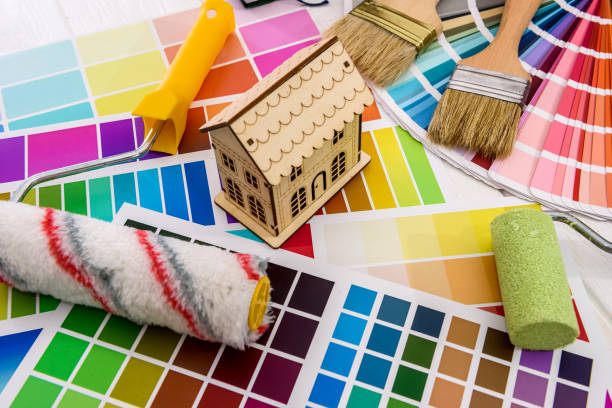It is only right that little ones can express themselves in a space of their own. When they are growing so fast, it can be difficult to accommodate their current needs and future ones. Children’s development is greatly influenced by stimulating environments and safe spaces. Children’s Bedroom Interior Design can be challenging and fun when you have to take into account so many factors.
These design and decorating tips for kids’ bedrooms will help you create a perfect space for your child. We have tips for you whether you are starting from scratch or want to optimize the interior of your child’s room.
When it comes to kids’ bedroom design, less is always more
Add nothing to the decor of your child’s room that is not necessary. Toys, books, and other study materials are all common among children of any age. Decor will only add to the clutter. Please keep it simple to help focus children, create an open play area, and reduce cleaning.
Choose Neutral Colors for Your Child’s Bedroom
It is particularly helpful for young children, whose tastes are constantly changing. You can update the decor of your child’s room with new pillows, artwork, and bedding. Your child will grow into a space that is unique to them. All of this is possible without spending a fortune every time you want to update.
The storage is essential for any kids’ room interior
There are many things that children have- toys, games, books, clothes, etc. It is important to have enough storage space for all the stuff that your child has.
A dresser is a great option for a nursery. Storage under the bed is ideal for seasonal items and things that will be used in the future. Once your child reaches maturity, an integrated wardrobe will house all of their belongings. It can include drawers for seasonal items and a vanity for them to use to get ready. There are also multiple levels to hang the clothes to make the most of the space.
It is a good idea to have a cubby for storage. This is especially true for items that you or your child would like to keep easily accessible. Toys, games, books, and art supplies can all be stored in a cubby. Organizing everything using storage baskets is easy. You can also use the cubby as a display for mementos and decor.
Consider Different Layouts when Designing a Child’s Bedroom
Select a layout to maximize the space. List everything you need in the room, and then try different arrangements of furniture to see what works. In a large enough room, twin beds are a good option for your children to share a bedroom. If the room is smaller, you might want to consider bunk beds. A raised bed can be used to create a study or reading area below the bed. This leaves room for play space.
Children of all ages can benefit from layouts that clearly delineate the different functional areas. They can regulate their routines with ease and develop a sense of accountability. They can focus on the task at hand, play, and have fun when they want to before relaxing for bedtime. Special nooks or separated areas will also make the room seem larger.
Select Children’s Bedroom furniture that grows with them
It is easier to keep up with the changing tastes and preferences of children if you use a neutral color palette. A few pieces of furniture which can grow with them are also essential. You will not have to redo your child’s room each time they have a growth spurt.
Start with a larger bed for kids. It will last several years. A solid frame can be updated with a new coat of paint or by changing the bedding. You can also add a canopy to your room without having to change the furniture. So, invest in durable pieces.
Dressers are another essential piece of furniture for kids’ rooms. You can update the look by changing the knobs or handles on the drawers. You can find cute and comfortable kids’ study seats, even if the study table is not adjustable. Easily transition from one stage to another with adjustable chairs.
Versatile lighting options can also be a great idea for designing a child’s room. Dimming and task lighting are great for a variety of designs. You can also add ambient lighting and night lamps.
Choose Children’s Bedrooms That Provide Multi-Sensorial Engagement
Color, patterns, and other visual stimuli are great ways to add visual stimulation to a space. There are many creative ways to use it. You can use fun false-ceiling designs, murals, quirky wallpapers, and glow-in-the-darkness stick-ons. Accessories are a great option. Use colorful bins as cubbies. You can also paint a toy and use it as a display. There are endless ideas for children’s bedrooms.
Textures and patterns can be powerful tools for decorating. They add visual interest to the room while providing tactile stimulation for children. Kids will love soft and plush textures as they create a comfortable and welcoming space. Fabrics like curtains, bed linen, throw pillows, and rugs are great for adding texture and color to a room.
A room with patterns can be dynamic. Wallpaper and textiles are a great place to start. It’s also a good opportunity to bring your child’s personality into their room. Find patterns related to their interests. For example, you can find patterns with animals, space, superheroes, sea creatures, or superheroes.
The TLC of children’s bedroom ideas is important.
Children need both a stimulating environment and a place to relax. A cozy, inviting corner in kids’ rooms can benefit them. Here, the kids can read a book, cuddle with their pets, or share secrets and laughs with friends.
You can create the perfect nook with soft seating, a throw blanket, moody lighting, and some pillows. It can be made on the floor, a window sill, or even with a study chair for kids and an ottoman.
It is important to get the flooring in children’s bedrooms right
It would be best if you chose a floor covering that is both gentle and safe for babies and easy to maintain and clean. Popular options include carpet, vinyl, rubber, and wood.
The carpet is soft, warm, absorbent, and soundproof. However, it can be hard to clean and isn’t the most hygienic. Refinishing can fix minor damage, but wood can last for a very long time. Natural or engineered hardwoods are free of VOCs and allergies. Vinyl is an excellent option because of its wide variety and ease of maintenance. However, it is not a viable option, and the VOCs it emits may cause health problems.
When designing a children’s bedroom, there are a few details to consider.
Make sure that you can clean and scrub the paint finish if necessary.
Consider how you and your child(ren) will use the space when you are planning a layout.
Include your child’s artwork in the decor. This will encourage them to continue creating and give the room a little change.
Don’t underestimate the size of your storage space.
Keep things accessible to the children by keeping them at their eye level.
You can dedicate a workstation to them so they can create or do their hobby.
Add some personal touches by adding mementos.
Get gentle lighting. While children may not require as much lighting as adults, a combination of ambient light, desk light, reading light, and night light is helpful.
Beautiful Homes can help you create the perfect room for your children.
Beautiful Homes offers a wide range of products and services. Our interior design services provide a personalized experience and bespoke solutions. Our professionals will ensure that your and your children’s needs and wants are met.
Visit our website to see the various options we offer and projects we have completed. Book a 3D call to learn more about the project, its design, and execution. Or, visit our stores in India to find out more.



